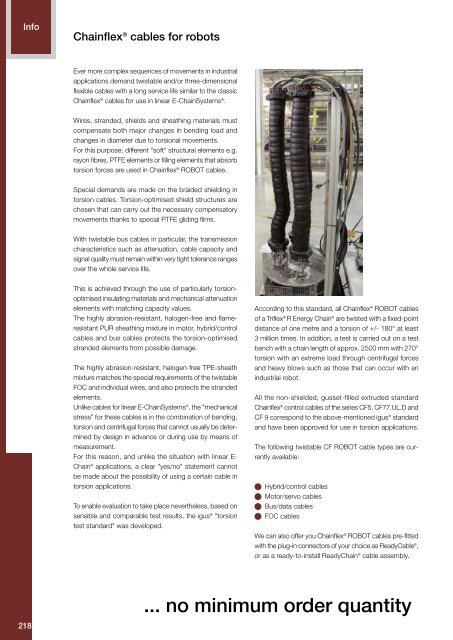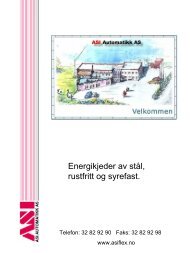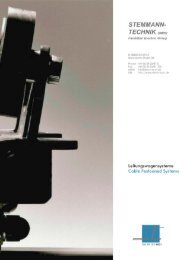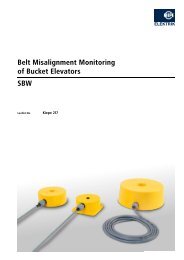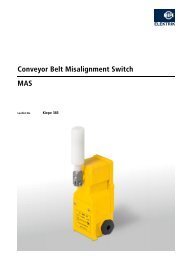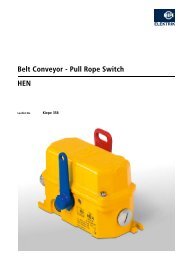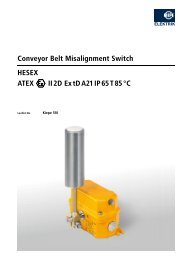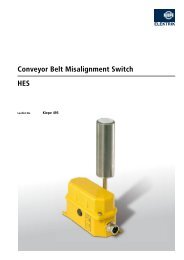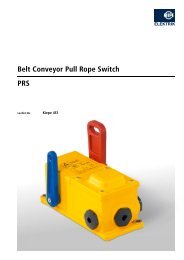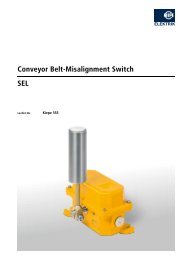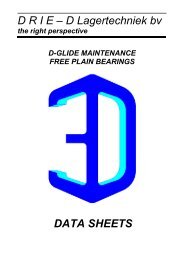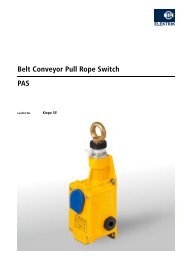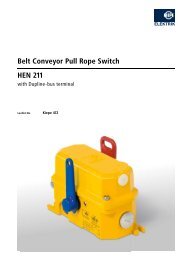- Page 1 and 2:
asts.Starting at 1 mlength.No minim
- Page 3 and 4:
Chainflex ® cable's classification
- Page 5 and 6:
Chainflex ®Chainflex ®cableJacket
- Page 7 and 8:
Chainflex ®Chainflex ®CableJacket
- Page 9 and 10:
Chainflex ®Chainflex ®CableJacket
- Page 11 and 12:
Chainflex ®Chainflex ®CableJacket
- Page 13 and 14:
Chainflex ® ReadyCable ®Cable typ
- Page 15 and 16:
Chainflex ® accessoryPageConnector
- Page 17 and 18:
How to use the catalog:Chainflex ®
- Page 19 and 20:
FleeceChainflex ® ...The tricks an
- Page 21 and 22:
Chainflex ® ...The tricks and inge
- Page 23 and 24:
Sectional views throughDetailed str
- Page 25 and 26:
Chainflex ® are thespecial cables
- Page 27 and 28:
Example 1: tested,tested, tested!Se
- Page 29 and 30:
Example 2: tested,tested, tested! T
- Page 31 and 32:
Example 3: tested,tested, tested!
- Page 33 and 34:
Example 4:tested, tested, tested!CF
- Page 35 and 36:
Example 5: tested!Dispersion and at
- Page 37 and 38:
Example 6: tested!Selection from te
- Page 39 and 40:
Example 8: tested, tested!Fibre opt
- Page 41 and 42:
Example 9: tested!Fast imagesFast i
- Page 43 and 44:
Example 10: tested!Light in the col
- Page 45 and 46:
Example 11: tested!Completely turne
- Page 47 and 48:
Example 12: tested,tested, tested!S
- Page 49 and 50:
Example 13: tested live!Container c
- Page 51 and 52:
Example 14: tested!Comparison of sh
- Page 53 and 54:
ontrol cables
- Page 55 and 56:
CF130.ULPVC7,5-10xdPVC Control cabl
- Page 57 and 58:
CF130.ULPVC7,5-10xdPVC Control cabl
- Page 59 and 60:
CF140.ULPVC7,5-15xdFine-wire strand
- Page 61 and 62:
CF140.ULPVC7,5-15xdPVC Control cabl
- Page 63 and 64:
CF5PVC6,8-7,5xdPVC Control cableCha
- Page 65 and 66:
CF5PVC6,8-7,5xdPVC Control cableCha
- Page 67 and 68:
CF6PVC6,8-7,5xdEspecially bendingre
- Page 69 and 70:
CF6PVC6,8-7,5xdPVC Control cableCha
- Page 71 and 72:
CF77.UL.DPUR6,8-7,5xdPUR Control ca
- Page 73 and 74:
CF78.ULPUR6,8-7,5xdFine-wire strand
- Page 75 and 76:
CF170.DPUR7,5-10xdPUR Control cable
- Page 77 and 78:
CF180PUR7,5-15xdFine-wire strandedc
- Page 79 and 80:
CF2PUR5 x dExtremely highflexible s
- Page 81 and 82:
CF2PUR5 x dPUR Control cableChainfl
- Page 83 and 84:
CF9TPE5 x dTPE Control cableChainfl
- Page 85 and 86:
CF9TPE5 x dTPE Control cableChainfl
- Page 87 and 88:
CF10TPE5 x dExtremely highflexible
- Page 89 and 90:
CF10TPE5 x dTPE Control cableChainf
- Page 91 and 92:
CF9.ULTPE5 x dTPE Control cableChai
- Page 93 and 94:
CF9.ULClass 6.4.4TPE5 x d90Image ex
- Page 95 and 96:
CF10.ULTPE5 x dHighly flexiblespeci
- Page 97 and 98:
CF10.ULTPE5 x dTPE Control cableCha
- Page 99 and 100:
CF98TPE4 x dTPE Control cableChainf
- Page 101 and 102:
CF99TPE4 x dExtremely highlyflexibl
- Page 103 and 104:
ata cablesus cables Encoder cables
- Page 105 and 106:
CF240PVC10-12 x dPVC Data cableChai
- Page 107 and 108:
CF211PVC10 x dCenter elementfor hig
- Page 109 and 110:
CF112PUR10 x dEspecially bendingres
- Page 111 and 112:
CF113PUR10 x dEspecially bendingres
- Page 113 and 114:
CF11TPE10 x dEspecially bendingresi
- Page 115 and 116:
CF12TPE10 x dEspecially bendingresi
- Page 117 and 118:
SelectionChainflex ®bus cableSelec
- Page 119 and 120:
SelectionChainflex ®bus cableSelec
- Page 121 and 122:
CFBUS.PVCPVC12,5 x dNew! PVC Bus ca
- Page 123 and 124:
CFBUS.PURPUR12,5 x dNew! PUR Bus ca
- Page 125 and 126:
CFBUSTPE10-12.5 x dTPE Bus cableCha
- Page 127 and 128:
CFBUSTPE10-12.5 x dTPE Bus cableCha
- Page 129 and 130:
CF11.LCTPE10 x dEspecially bendingr
- Page 131 and 132:
CF11.LC.DTPE10 x dEspecially bendin
- Page 133 and 134:
CF14TPE12,5 x dEspecially bendingre
- Page 135 and 136:
CF211PVC10 x dCenter elementfor hig
- Page 137 and 138:
CF211PVC10 x dPVC Measuring system
- Page 139 and 140:
CF113.DPUR10 x dEspecially bendingr
- Page 141 and 142:
CF113.DPUR10 x dPUR Measuring syste
- Page 143 and 144:
CF113.DPUR10 x dPUR Measuring syste
- Page 145 and 146:
CF111.DTPE12 x dCenter elementfor h
- Page 147 and 148:
CF111.DTPE12 x dTPE Measuring syste
- Page 149 and 150:
CF11.DTPE10 x dEspecially bendingre
- Page 151 and 152:
CF11.DTPE10 x dTPE Measuring system
- Page 153 and 154:
CF11.DTPE10 x dTPE Measuring system
- Page 155 and 156:
CF Koax 1TPE10 x dEspecially bendin
- Page 157 and 158:
ibre optic cables
- Page 159 and 160:
InfoThe safest and often cheapest w
- Page 161 and 162:
CFLKPUR12,5 x dPUR Fibre optic cabl
- Page 163 and 164:
CFLG.2HPUR12,5 x dFOC-fibresPUR Fib
- Page 165 and 166:
CFLG.LBTPE5 x dFOC cores with hight
- Page 167 and 168:
CFLG. GTPE15 x dTPE Fibre optic cab
- Page 169 and 170: 166ervo cables
- Page 171 and 172: CF210.ULPVC10 x dBending-resistantc
- Page 173 and 174: CF21.ULPVC7,5 x dHighly flexiblespe
- Page 175 and 176: CF21.ULPVC7,5 x dPVC Servo cableCha
- Page 177 and 178: CF270.UL.DPUR10 x dBending-resistan
- Page 179 and 180: CF270.UL.DPUR10 x dPUR Servo cableC
- Page 181 and 182: CF27.DPUR7,5 x dHighly flexiblespec
- Page 183 and 184: CF27.DPUR7,5 x dPUR Servo cableChai
- Page 185 and 186: 182ower cable
- Page 187 and 188: CF30PVC7,5 x dPVC Power cableChainf
- Page 189 and 190: CF31PVC7,5 x dHighly flexiblespecia
- Page 191 and 192: CF34.UL.DTPE7,5 x dTPE Power cableC
- Page 193 and 194: CF35.ULTPE7,5 x dHighly flexiblespe
- Page 195 and 196: CF37.DTPE7,5 x dTPE power cableChai
- Page 197 and 198: CF38TPE7,5 x dTPE power cableChainf
- Page 199 and 200: CF300.UL.DTPE7,5 x dHighly flexible
- Page 201 and 202: CFPETPE7,5 x dHighly flexiblespecia
- Page 203 and 204: CF310.ULTPE7,5 x dHighly flexiblesp
- Page 205 and 206: CF330.DTPE7,5 x dHighly flexiblespe
- Page 207 and 208: CF340TPE7,5 x dHighly flexiblespeci
- Page 209 and 210: CF FLATTPE5 x dHighly flexible brai
- Page 211 and 212: CFBRAIDTPE7,5 x dHighly flexiblespe
- Page 213 and 214: CF CRANEiguprene10 x digupren Power
- Page 215 and 216: CFAIRPU10 x dPneumatic hoseChainfle
- Page 217 and 218: CF Clean AIRPE10 x dPneumatic hoseC
- Page 219: obotwistable cables
- Page 223 and 224: CFROBOT9PUR± 180°Highly flexibles
- Page 225 and 226: CFROBOT8PUR± 180°Especially bendi
- Page 227 and 228: CFROBOT4PUR± 180°Highly flexible
- Page 229 and 230: CFROBOT5TPE± 180°FOC cores with h
- Page 231 and 232: CFROBOT6/7PUR± 180°Highly flexibl
- Page 233 and 234: CF ROBOTTPE± 90°Extremely bendres
- Page 235 and 236: ameraideo-, vision engineering/bus
- Page 237 and 238: FireWireTPE12,5 x dTPE Bus cableCha
- Page 239 and 240: FireWireTPE12,5 x dTPE Bus cableCha
- Page 241 and 242: USBTPE12,5 x dTPE Bus cableChainfle
- Page 243 and 244: USBTPE12,5 x dTPE Bus cableChainfle
- Page 245 and 246: GigETPE12,5 x dEspecially bendingre
- Page 247 and 248: FOCPUR12,5 x dGradient fibersPUR Fi
- Page 249 and 250: FOCPUR12,5 x dPUR Fibre optic cable
- Page 251 and 252: ROBOT-FOCTPE12,5 x dFOC wires with
- Page 253 and 254: CF Koax 1TPE10 x dEspecially bendin
- Page 255 and 256: CF Koax 1TPE10 x dTPE Koax cableCha
- Page 257 and 258: ContentCamera reference list - Sele
- Page 259 and 260: ContentCamera reference list - Sele
- Page 261 and 262: etworketwork-/Ethernet-/FOC-cable/F
- Page 263 and 264: CFLG.6GTPE15 x dTPE Fibre optic cab
- Page 265 and 266: CFLG.12GTPE15 x dTPE Fibre optic ca
- Page 267 and 268: CAT5Chainflex ® network techniqueC
- Page 269 and 270: CAT5Chainflex ® network techniqueC
- Page 271 and 272:
CAT6Chainflex ® network techniqueC
- Page 273 and 274:
ProfibusPVCChainflex ® network tec
- Page 275 and 276:
ProfibusPURChainflex ® network tec
- Page 277 and 278:
ProfibusTPEChainflex ® network tec
- Page 279 and 280:
F.INInitiators
- Page 281 and 282:
CF.INICF9CF.INIChainflex ® Sensor/
- Page 283 and 284:
CF.INICF9CF.INIChainflex ® Sensor/
- Page 285 and 286:
CF.INICF9CF.INIChainflex ® Sensor/
- Page 287 and 288:
CF.INICF10CF.INIChainflex ® Sensor
- Page 289 and 290:
CF.INICF98CF.INIChainflex ® Sensor
- Page 291 and 292:
CF.INICF98CF.INIChainflex ® Sensor
- Page 293 and 294:
290
- Page 295 and 296:
ContentChainflex ® ReadyCable ®Ca
- Page 297 and 298:
ContentChainflex ® ReadyCable ®29
- Page 299 and 300:
ContentChainflex ® ReadyCable ®BA
- Page 301 and 302:
ContentChainflex ® ReadyCable ®29
- Page 303 and 304:
ContentChainflex ® ReadyCable ®DA
- Page 305 and 306:
ContentChainflex ® ReadyCable ®30
- Page 307 and 308:
ContentChainflex ® ReadyCable ®RE
- Page 309 and 310:
ContentChainflex ® ReadyCable ®30
- Page 311 and 312:
ServoPVCChainflex ® -PVC-Servo cab
- Page 313 and 314:
ServoPVCChainflex ® -PVC-Servo cab
- Page 315 and 316:
ServoPVCChainflex ® -PVC-Servo cab
- Page 317 and 318:
ServoPVCChainflex ® -PVC-Servo cab
- Page 319 and 320:
ServoPVCChainflex ® -PVC-Servo cab
- Page 321 and 322:
ServoPVCChainflex ® -PVC-Servo cab
- Page 323 and 324:
ServoPVCChainflex ® -PVC-Servo cab
- Page 325 and 326:
ServoPVCChainflex ® -PVC-Servo cab
- Page 327 and 328:
ServoPURChainflex ® -PUR-Servo cab
- Page 329 and 330:
ServoPURChainflex ® -PUR-Servo cab
- Page 331 and 332:
ServoPURChainflex ® -PUR-Servo cab
- Page 333 and 334:
ServoPURChainflex ® -PUR-Servo cab
- Page 335 and 336:
ServoPURChainflex ® -PUR-Servo cab
- Page 337 and 338:
ServoPURChainflex ® -PUR-Servo cab
- Page 339 and 340:
ServoPURChainflex ® -PUR-Servo cab
- Page 341 and 342:
ServoPURChainflex ® -PUR-Servo cab
- Page 343 and 344:
ServoPURChainflex ® -PUR-Servo cab
- Page 345 and 346:
ServoPURChainflex ® -PUR-Servo cab
- Page 347 and 348:
PowerPVCChainflex ® -PVC power cab
- Page 349 and 350:
PowerPVCChainflex ® -PVC power cab
- Page 351 and 352:
PowerPVCChainflex ® -PVC power cab
- Page 353 and 354:
PowerTPEChainflex ® -TPE power cab
- Page 355 and 356:
PowerTPEChainflex ® -TPE power cab
- Page 357 and 358:
PowerTPEChainflex ® -TPE power cab
- Page 359 and 360:
DataPVCChainflex ® -PVC Data cable
- Page 361 and 362:
DataPVCChainflex ® -PVC Data cable
- Page 363 and 364:
MeasuringPVCChainflex ® -PVC Measu
- Page 365 and 366:
MeasuringPVCChainflex ® -PVC Measu
- Page 367 and 368:
MeasuringPVCChainflex ® -PVC Measu
- Page 369 and 370:
MeasuringPVCChainflex ® -PVC Measu
- Page 371 and 372:
MeasuringPVCChainflex ® -PVC Measu
- Page 373 and 374:
MeasuringPVCChainflex ® -PVC Measu
- Page 375 and 376:
DataPURChainflex ® -PUR Data cable
- Page 377 and 378:
MeasuringPURChainflex ® -PUR Measu
- Page 379 and 380:
MeasuringPURChainflex ® -PUR Measu
- Page 381 and 382:
DataTPEChainflex ® -TPE Data cable
- Page 383 and 384:
MeasuringTPEChainflex ® -TPE Measu
- Page 385 and 386:
MeasuringTPEChainflex ® -TPE Measu
- Page 387 and 388:
MeasuringTPEChainflex ® -TPE Measu
- Page 389 and 390:
MeasuringTPEChainflex ® -TPE Measu
- Page 391 and 392:
MeasuringTPEChainflex ® -TPE Measu
- Page 393 and 394:
MeasuringTPEChainflex ® -TPE Measu
- Page 395 and 396:
MeasuringTPEChainflex ® -TPE Measu
- Page 397 and 398:
MeasuringTPEChainflex ® -TPE Measu
- Page 399 and 400:
BusTPEChainflex ® -TPE Bus cable
- Page 401 and 402:
ControlPVCChainflex ® -PVC Control
- Page 403 and 404:
ControlPVCChainflex ® -PVC Control
- Page 405 and 406:
ControlTPEChainflex ® -TPE Control
- Page 407 and 408:
gusconnectors®
- Page 409 and 410:
SERIESAigus ® connectors SERIES Aa
- Page 411 and 412:
SERIESAigus ® connectors SERIES Aa
- Page 413 and 414:
SERIESBigus ® connectors SERIES Ba
- Page 415 and 416:
SERIESBigus ® connectors SERIES Ba
- Page 417 and 418:
SERIESM17igus ® connectors SERIES
- Page 419 and 420:
SERIESCigus ® connectors SERIES Ca
- Page 421 and 422:
SERIESDigus ® connectors SERIES Da
- Page 423 and 424:
SERIES Sigus ® connectors SERIES S
- Page 425 and 426:
ToolsAccessoriesigus ® tools, acce
- Page 427 and 428:
SUB-Digus ® Connectors SUB-Daccord
- Page 429 and 430:
SUB-Digus ® Connectors SUB-Daccord
- Page 431 and 432:
SERIESHSK-Kigus ® Cable glands HSK
- Page 433 and 434:
SERIESHSK-Migus ® Cable glands HSK
- Page 435 and 436:
SERIESHSK-M-EMVigus ® Cable glands
- Page 437 and 438:
SERIESHSK-M-EMV-Digus ® Cable glan
- Page 439 and 440:
VAKAT
- Page 441 and 442:
ChainfixOverview Strain Relief Syst
- Page 443 and 444:
ChainfixChainfix for Energy Chain S
- Page 445 and 446:
Chainfixigus ® Chainfix Strain Rel
- Page 447 and 448:
ChainfixChainfix - Snap on Solution
- Page 449 and 450:
ChainfixChainfix Tiewrap Platesigus
- Page 451 and 452:
VAKAT
- Page 453 and 454:
Increase cash flowIncrease your cas
- Page 455 and 456:
igus ® ReadyChain ®Increase cash-
- Page 457 and 458:
ReadyChain®FactoryLongstanding exp
- Page 459 and 460:
ApplicationsExamples for successful
- Page 461:
PlanningReduce your planning expens
- Page 464 and 465:
Chainflex ®PageTechnical Data and
- Page 466 and 467:
Designing the Filling Cables and Ho
- Page 468 and 469:
Designing the Filling Electrical Ro
- Page 470 and 471:
Design InformationDesigningwith igu
- Page 472 and 473:
Special Cables Information Load-Car
- Page 474 and 475:
Special Cables Information Electrot
- Page 476 and 477:
Special Cables Information Electrot
- Page 478 and 479:
Special Cables Information Electrot
- Page 480 and 481:
Special Cables Information Chemical
- Page 482 and 483:
Special Cables Information Approbat
- Page 484 and 485:
Noteswww.igus.euinfo@igus.deigus ®
- Page 486 and 487:
igus ® at www.igus.euMoreigus ®pr
- Page 488 and 489:
CF12CFBUSBus CablesCF11.LCCF11.LC.D
- Page 490 and 491:
Chainflex ® according to Industrie
- Page 492 and 493:
Energy Chain Systems ®System Plann
- Page 494 and 495:
Fax order Fax inquiry Chainflex ®F
- Page 496 and 497:
Table of contents according to part
- Page 498 and 499:
Table of contents according to part
- Page 500 and 501:
Table of contents according to part
- Page 502:
Noteswww.igus.euinfo@igus.deigus ®
- Page 506 and 507:
Noteswww.igus.euinfo@igus.deigus ®
- Page 508 and 509:
Noteswww.igus.euinfo@igus.deigus ®
- Page 510 and 511:
Noteswww.igus.euinfo@igus.deigus ®
- Page 512 and 513:
Noteswww.igus.euinfo@igus.deigus ®
- Page 514 and 515:
Noteswww.igus.euinfo@igus.deigus ®
- Page 516 and 517:
Give us your opinion!Yes, we can! C
- Page 519:
.eu/...®Ordering and deliveries we


